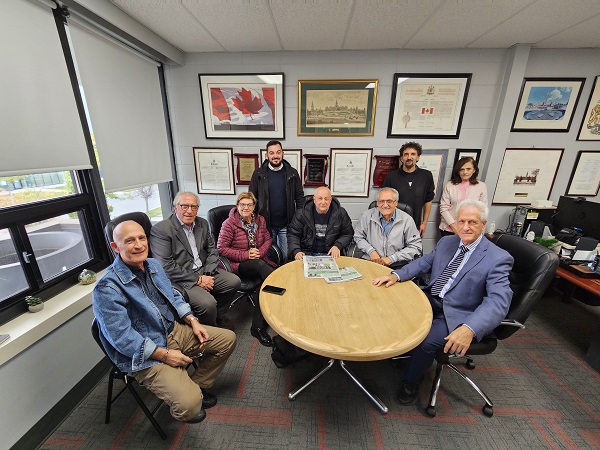The nexus of the South:
L’ombelico del Mezzogiorno

TORONTO – From a geographic and historical perspective, it is an almost natural development of a history bestowing Monteleone a reputation as a meeting place of peoples (races), civilizations, cultures gifting it with immense potential.
Once dispensed with the diplomatic niceties of how Mayor Giovanni Campese, the Speaker of the town Council, Pasquale Rigillo, and small delegation of family members, President Luigi Nunno of the Monteleone Cultural Club ceded the explanations swirling around the significance of his, also mine, hometown, and, the “purpose” of the visit.
Monteleone, provincia di Foggia (today) sitting at 847 meters (2.795 ft) above sea level, is the highest inhabited peak in the region of Puglia. It is almost equidistant, as the crow flies, from the Adriatic and the Tyrranean Seas. For centuries, if not Millenia, the area has hosted peoples travelling as migrants, armies and invaders from the eastern Mediterranean, Peninsular Italy and Northern Europe. It seemed a natural place for Greeks, Indigenous Samnites, “Latins”, Celts, Lombards, Franks, Arabs, Normans, Swabians, Africans, Arabs, Spaniards and French to attempt to colonize.
The stories and significances of their efforts to settle and prosper rolled off the tongue of Mayor Campese as would the fabulous tales being recounted to starry-eyed captive audience of eager children seated attentively on a Library floor. The town is truly an example of multiculturalism at its most successful, one might say, added Campese. Yet, its “descendants” in the last two centuries, for economic and political reasons, emigrated to populate and enrich other lands in other “worlds”.
“It would serve no purpose to bemoan this historic fact. Rather, our Council has determined to regenerate those ‘creative juices’ exhibited by our predecessors and celebrated what and how our town can contribute to the newest of our “cousins” – from everywhere – who seek a better life: a civilization based on a ‘civitas’ in which we are well practised”, enthused Campese, “because ours is a history of ‘making it work’, of ‘finding solutions’.
“We have underutilized infrastructure, physical and social, that should serve as feasibility projects, opportunities for destination points, for ‘in loco studies’, for tourism and for permanent settlements. The National government of Italy has already placed such goals on its Agenda, ‘allocated funds’ for their realization and put out a call for partnerships… Monteleonesi in North America – right here in Toronto – have proven themselves leaders of renown in construction, finance, education, the arts and other professions”.
“The innovative drive and ambition to so seek solutions is still part of our DNA. We want our former residents to rediscover themselves in their place of origin, share their experience and regenerate what works for the younger families that have stayed behind or are attracted by the successes our Diaspora has tasted and spread.” One could ask for some examples… but there is no stopping a true believer with patience.
“Imagine, the daughter of Martin Luther King coming to our “far away town” to establish a bona fide center for studies in racial equality and peace. It happens in Monteleone. Think about those studies expanding to women’s issues. Can you think of a better place than Monteleone, where women have a well-established history of rebelling against oppression and maladministration? Think of our “Leonesse” during the Spanish Inquisition or their revolt against fascist overlords in World War two. On a more positive note, Monteleone alone among the towns in our region (province) has established centres of “accoglienza ed integrazione” for the new immigrants pouring into our peninsula. We are what you in Canada call “a happening place”. Our “murales” adorn the uninhabited spaces, our cuisine satisfies the tastebuds of the cognoscenti, our festivals reinforce our values”.
He might have explored those themes for longer, but I asked him to reflect briefly on Monteleone’s Norman past and its relationship with the Canadian parliamentary system. It turns out that the oldest verified precursor of that parliamentary system was not the Norman/Angevin meeting at Runnymede (England) between King John and his barons. It was a time-honored tradition of parlement (solution-seeking courts of assise) European historians have traced back to Roger II, in 1042 AD, in Monteleone, then a centre of Norman control.
That surely could be an impetus for a course of study in bringing people together. Mayor Campese will be hosted by the Toronto Monteleonesi, Saturday night at Montecassino Place on Chesswood Dr.
In the pic above, from the left: the Monteleone delegation in the editorial office of Corriere Canadese, with Alfonso Sacco, Pasquale Rigillo, Olimpia Guerriero, Leonardo Campese, Giovanni Campese and Luigi Nunno, with the editor-in-chief of the Corriere Canadese, Francesco Veronesi, the deputy editor-in-chief Mariella Policheni and the publisher Joe Volpe; here below, the video “Monteleone di Puglia: il paese dell’Accoglienza”



